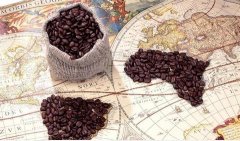Fine Coffee Science espresso espresso is the essence of coffee

In terms of pure sensory entertainment, there are few experiences in daily life that can be comparable to a good cup of coffee. The charming fragrance of a cup of hot, smoking coffee just brewed from freshly roasted beans can pull sleeping people out of bed and lead passers-by into the cafe. Millions of people around the world would have trouble getting through the day without a bout of sanity caused by the caffeine in their coffee. Only in this seemingly ordinary drink, but there is a very complex chemistry. Various ways from the production and roasting of coffee beans to the preparation of coffee have a subtle impact on hundreds of chemicals and define the taste, aroma and texture of coffee. If there is no in-depth understanding of the above, it will be a rare opportunity and pure luck to have a good cup of coffee.
Connoisseurs agree that espresso (espresso) is the essence of coffee: a small, strong magnetic cup filled with a half-full dark, opaque drip filtrate with a mellow, reddish-brown foam called crema. Klima is composed of fine bubbles wrapped in thin film, which is closely related to the unique taste and flavor of coffee, as well as its heat. The word Espresso is meant to be made upon request. As for the practice is to grind the roasted coffee into fine grains, press it into a cake, and filter it quickly with a small amount of pressurized and heated water. The resulting concentrated liquid contains not only melted solids, but also a large number of various spice substances in the scattered tiny oil droplets suspension. All these add up to the unique strong taste, smell and "taste" of espresso.
Addicts believe that the perfect espresso is the best because of its special preparation method, which shows and strengthens the natural characteristics of coffee beans. In fact, espresso is the essence of all kinds of coffee-making methods, from the Turkish method to various leaching methods to filtering leaks (see the introduction of other coffee-making methods in the text box on the page); as long as you know the practice of espresso, you know all the forms of coffee making, so it is more appropriate to take it as an example.
High-quality coffee comes from maintaining tight control over a variety of factors, from soil to plants to cups. There are countless variables in the cultivation of coffee that must be paid attention to and control. once the coffee beans bear fruit, the quality has been determined, and nothing can be added or removed. For an espresso, it takes 50 to 55 beans; one imperfect bean is enough to cause pollution. That's because the human sense of smell and taste begins with a self-defense mechanism to protect our ancestors from decay, that is, unhealthy food. Only by relying on modern technology can it be economical and stable to identify 50 perfect coffee beans.
Important Notice :
前街咖啡 FrontStreet Coffee has moved to new addredd:
FrontStreet Coffee Address: 315,Donghua East Road,GuangZhou
Tel:020 38364473
- Prev

Basic knowledge of boutique coffee beans where does coffee come from?
Chickens can be divided into cocks and hens, but are there any differences between male and female eggs? Recently, the saying of public beans and mother beans is quite popular. A friend who has just returned from Bali, Indonesia, and the bar manager of a five-star hotel both talked about it with me. The former said that when she went to Bali, the locals recommended public beans to her and did a cup test on the spot. The taste of male beans is obviously better than that of mother beans; the latter boasts to me that they supply
- Next

Basic knowledge of boutique coffee knowledge of growing coffee
Raw coffee beans are the seeds of Rubiaceae, and there are at least 66 species in the genus Coffea. Two of the commercial interests are Arabica (Coffea arabica) and Congolese coffee (C. canephora). The former accounts for 2/3 of the world's production, while the latter, also known as Robusta, accounts for the remaining 1/3. Robastaga
Related
- Beginners will see the "Coffee pull flower" guide!
- What is the difference between ice blog purified milk and ordinary milk coffee?
- Why is the Philippines the largest producer of crops in Liberia?
- For coffee extraction, should the fine powder be retained?
- How does extracted espresso fill pressed powder? How much strength does it take to press the powder?
- How to make jasmine cold extract coffee? Is the jasmine + latte good?
- Will this little toy really make the coffee taste better? How does Lily Drip affect coffee extraction?
- Will the action of slapping the filter cup also affect coffee extraction?
- What's the difference between powder-to-water ratio and powder-to-liquid ratio?
- What is the Ethiopian local species? What does it have to do with Heirloom native species?

